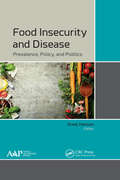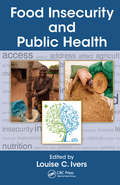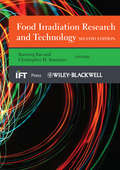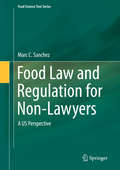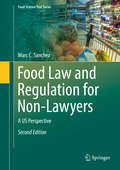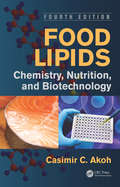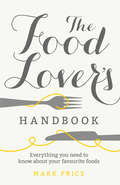- Table View
- List View
The Food Industry Innovation School: How to Drive Innovation through Complex Organizations
by Helmut TraitlerInnovation and new product development are increasingly perceived as drivers of profits in the food industry. Companies are dedicating a large amount of resources to these areas and it is crucial that individuals understand how to be part of this new strategy. Food Industry Innovation School focuses on key skills needed to drive new ideas from initial concepts through to successful products on the shelf. The author argues that any individual can learn how to lead innovation within complex organizations utilizing companies? commercial and financial resources. The book focuses on the impact of single individuals on company successes. Case studies from the marketplace provide valuable examples of accomplishments and failures. Product development involves a plethora of activities such as R&D,innovation, engineering, packaging and design, manufacturing,logistics and supply chain management, as well as marketing, sales and finance, and the book addresses all these crucial functions undertaken by food companies and manufacturers of other packaged consumer goods. The learning principles and examples (based on the author's personal experience) are valid in many fast-moving consumer goods organizations and so the principles, best practices and solutions offered in the 12 chapters are relevant to a wide audience in the food industry and beyond, including those working in household products, retail, the automotive industry, computers and IT, furniture, and even media and publishing. Read more: http://www.innovationschool.co/
Food Industry R&D: A New Approach
by Helmut Traitler Birgit Coleman Adam BurbidgeResearch and development represents a vast spread of topics and can be an arena for controversy. In academia, such controversy may stem from conflicting interpretations of data and subsequent conclusions, the question of who was first to discover a particular finding and whether or not the said finding is of any value to the scientific community. R&D in corporate environments is mostly defined and driven by costs and clearly identified, consumer-focused targets. There is, however, common ground between these two approaches as both strive to maximize knowledge, though for different reasons and in differnt ways. The equipment and scientific rigor may be similar or identical, however their usage, approach and interpretation are different. This book discusses the history and background of today's food industry R&D as seen by consumers, academia and the industry itself, with several chapters dedicated to new and disruptive approaches. A must-read for all professionals in the packaged goods industry as well as students who aspire to contribute to this new industry, forcefully driven by R&D.
Food Industry R&D: A New Approach
by Helmut Traitler Birgit Coleman Adam BurbidgeResearch and development represents a vast spread of topics and can be an arena for controversy. In academia, such controversy may stem from conflicting interpretations of data and subsequent conclusions, the question of who was first to discover a particular finding and whether or not the said finding is of any value to the scientific community. R&D in corporate environments is mostly defined and driven by costs and clearly identified, consumer-focused targets. There is, however, common ground between these two approaches as both strive to maximize knowledge, though for different reasons and in differnt ways. The equipment and scientific rigor may be similar or identical, however their usage, approach and interpretation are different. This book discusses the history and background of today's food industry R&D as seen by consumers, academia and the industry itself, with several chapters dedicated to new and disruptive approaches. A must-read for all professionals in the packaged goods industry as well as students who aspire to contribute to this new industry, forcefully driven by R&D.
Food Insecurity and Disease: Prevalence, Policy, and Politics
by Areej HassanFood insecurity and disease are inextricably linked. The chapters in this valuable articles compendium reinforce that message by specifically linking food insecurity to various forms of chronic disease, including HIV/AIDS and obesity, as well as mental health issues. Providing a nuanced look at food insecurity and its connection to disease, the quality of the research gathered here advances our understanding of this issue; the chapter authors have provided us with a solid foundation on which to build well-informed clinical practice, further research, and effective future policy.This informative compendium will provide insight on these important issues for students and scholars in security studies, international politics, and environmental studies.
Food Insecurity and Disease: Prevalence, Policy, and Politics
by Areej HassanFood insecurity and disease are inextricably linked. The chapters in this valuable articles compendium reinforce that message by specifically linking food insecurity to various forms of chronic disease, including HIV/AIDS and obesity, as well as mental health issues. Providing a nuanced look at food insecurity and its connection to disease, the quality of the research gathered here advances our understanding of this issue; the chapter authors have provided us with a solid foundation on which to build well-informed clinical practice, further research, and effective future policy.This informative compendium will provide insight on these important issues for students and scholars in security studies, international politics, and environmental studies.
Food Insecurity and Public Health
by Louise IversAffecting more than 800 million people, food insecurity is a global problem that runs deeper than hunger and undernutrition. In addition to the obvious impact on physical well-being, food insecurity can result in risky coping strategies, increased expenditures on medical costs or transportation, and mental health issues. A review of the concepts an
Food Insecurity and Public Health
by Louise IversAffecting more than 800 million people, food insecurity is a global problem that runs deeper than hunger and undernutrition. In addition to the obvious impact on physical well-being, food insecurity can result in risky coping strategies, increased expenditures on medical costs or transportation, and mental health issues. A review of the concepts an
Food Insecurity & Hydroclimate in Greater Horn of Africa: Potential for Agriculture Amidst Extremes
by Joseph AwangeThis book will benefit users in food security, agriculture, water management, and environmental sectors. It provides the first comprehensive analysis of Greater Horn of Africa (GHA)’s food insecurity and hydroclimate using the state-of-the-art Gravity Recovery and Climate Experiment (GRACE) and its Follow-on (GRACE-FO)’s, centennial precipitation, hydrological models’ and reanalysis’ products. It is here opined that GHA is endowed with freshwater (surface and groundwater) being home to the world's second largest freshwater body (Lake Victoria) and the greatest continental water towers (Ethiopian Highlands) that if properly tapped in a sustainable way, will support its irrigated agriculture as well as pastoralism. First, however, the obsolete Nile treaties that hamper the use of Lake Victoria (White Nile) and Ethiopian Highland (Blue Nile) have to be unlocked. Moreover, GHA is bedevilled by poor governance and the ``donor-assistance” syndrome; and in 2020-2021 faced the so-called ``triple threats’’ of desert locust infestation, climate variability/change impacts and COVID-19 pandemic. Besides, climate extremes influence its meagre waters leading to perennial food insecurity. Coupled with frequent regional and local conflicts, high population growth rate, low crop yield, invasion of migratory pests, contagious human and livestock diseases (such as HIV/AIDs, COVID-19 & Rift Valley fever) and poverty, life for more than 310 million of its inhabitants simply becomes unbearable. Alarming also is the fact that drought-like humanitarian crises are increasing in GHA despite recent progress in its monitoring and prediction efforts. Notwithstanding these efforts, there remain challenges stemming from uncertainty in its prediction, and the inflexibility and limited buffering capacity of the recurrent impacted systems. To achieve greater food security, therefore, in addition to boosting GHA's agricultural output, UN Office for the Coordination of Humanitarian Affairs suggest that its “inhabitants must create more diverse and stable means of livelihood to insulate themselves and their households from external shocks”. This is a task that they acknowledge will not be easy as the path ahead is “strewn with obstacles namely; natural hazards and armed conflicts”. Understanding GHA’s food insecurity and its hydroclimate as presented in this book is a good starting point towards managing the impacts of the natural hazards on the one hand while understanding the impacts associated with extreme climate on GHA's available water and assessing the potential of its surface and groundwater to support its irrigated agriculture and pastoralism would be the first step towards “coping with drought” on the other hand.The book represents a significant effort by Prof Awange in trying to offer a comprehensive overview of the hydroclimate in the Greater Horn of Africa (GHA). Prof Eric F. Wood, NAE (USA); FRSC (Canada); Foreign member, ATSE (Australia).
Food Intake in Fish
by Dominic Houlihan Thierry Boujard Malcolm JoblingThe intake of food by fishes is an area of study that is of great importance to the applied sciences of fisheries and aquaculture for a number of reasons. For example a thorough knowledge of factors influencing the ingestion of feed can lead to successful manipulation of the rearing environment of cultured fishes, thereby ensuring improved growth performance and feed utilisation, and decreasing the amount of waste (and consequent pollution) per unit of fish produced. This important book, which has arisen out of a European Union COST programme, illustrates how insights into the biological and environmental factors that underlie the feeding responses of fish may be used to address practical issues of feed management. Food Intake in Fish contains carefully edited contributions from internationally recognised scientists, providing a book that is an invaluable tool and reference to all those involved in aquaculture, especially those working in the aquaculture feed industry and scientific personnel in commercial and research aquaculture facilities. This book should also find a place on the shelves of fish biologists and physiologists and as a reference in libraries of universities, research establishments and aquaculture equipment companies.
Food Intolerances: A Technological Perspective
by Felipe Richter ReisWhile modern food production has become increasingly efficient in providing a wide range of convenient and affordable products, individuals struggling with gluten intolerance, FODMAP intolerance, and intolerance to food additives are an exception when their health conditions limit the foods they can safely eat. Food intolerances, usually dealt with from a health perspective, also have technological aspects, especially as one takes into consideration that foods designed for individuals with food intolerances require specific ingredients, formulations, and processing conditions.Food Intolerances: A Technological Perspective addresses the health and food science aspects of food intolerances from a technological perspective, which is rarely considered in other books. Valuable data on products and production processes for designing foods for people who have food intolerances are presented in a way that various types of food industries can benefit from.Key Features: Compiles health and food science aspects of food intolerances in a single location Addresses clean label food products and links them to food additive intolerances Discusses the mechanisms behind the changes in food product quality after ingredient substitution and compound removal in gluten-free, low-FODMAP, and clean label products Provides perspectives and future trends in the development of food products for people who have food intolerances A compilation of research from prominent medical doctors and PhDs in food science from around the world, this book is helpful for food science students and industry professionals alike.
Food Intolerances: A Technological Perspective
While modern food production has become increasingly efficient in providing a wide range of convenient and affordable products, individuals struggling with gluten intolerance, FODMAP intolerance, and intolerance to food additives are an exception when their health conditions limit the foods they can safely eat. Food intolerances, usually dealt with from a health perspective, also have technological aspects, especially as one takes into consideration that foods designed for individuals with food intolerances require specific ingredients, formulations, and processing conditions.Food Intolerances: A Technological Perspective addresses the health and food science aspects of food intolerances from a technological perspective, which is rarely considered in other books. Valuable data on products and production processes for designing foods for people who have food intolerances are presented in a way that various types of food industries can benefit from.Key Features: Compiles health and food science aspects of food intolerances in a single location Addresses clean label food products and links them to food additive intolerances Discusses the mechanisms behind the changes in food product quality after ingredient substitution and compound removal in gluten-free, low-FODMAP, and clean label products Provides perspectives and future trends in the development of food products for people who have food intolerances A compilation of research from prominent medical doctors and PhDs in food science from around the world, this book is helpful for food science students and industry professionals alike.
Food Irradiation: A Guidebook, Second Edition
by Morton SatinFood irradiation has been in the news lately, and this news strongly favors the consideration of food irradiation as a practical, economical method for improving food safety and shelf life. This new edition of a popular guidebook provides an updated, detailed, readable survey of the past, present and future of food irradiation. It covers a wide variety of topics ranging from the scientific basics to an examination of the many objections to food irradiation. Also included is a detailed discussion of the role of food irradiation in preventing a variety of foodborne diseases.
Food Irradiation: A Guidebook, Second Edition
by Morton SatinFood irradiation has been in the news lately, and this news strongly favors the consideration of food irradiation as a practical, economical method for improving food safety and shelf life. This new edition of a popular guidebook provides an updated, detailed, readable survey of the past, present and future of food irradiation. It covers a wide variety of topics ranging from the scientific basics to an examination of the many objections to food irradiation. Also included is a detailed discussion of the role of food irradiation in preventing a variety of foodborne diseases.
Food Irradiation Research and Technology (Institute of Food Technologists Series #68)
by Xuetong Fan Christopher H. SommersThe benefits of food irradiation to the public health have been described extensively by organizations such as the Centers for Disease Control and Prevention in the USA and the World Health Organization. The American Medical Association and the American Dietetic Association have both endorsed the irradiation process. Yet the potential health benefits of irradiation are unknown to many consumers and food industry representatives who are wary of irradiated foods due to myth-information from “consumer-advocate” groups. This updated second edition of Food Irradiation Research and Technology reviews the latest developments in irradiation technologies as they are applied to meat, seafood fish, fruits, vegetables and nuts. Experts from industry, government, and academia define the basic principles and public health benefits of irradiation. New chapters in this edition address irradiation chemistry, including furan formation due to irradiation, irradiation of packaging materials, processing irradiation technologies and parameters, and ready-to-eat meat products. Coverage of safety and quality of fresh fruits and vegetables, phytosanitary applications and consumer acceptance has been expanded to address recent interest and development. The book is designed to appeal to a broad readership: industry food scientists involved in the processing of meat and fish, fruits and vegetables; food microbiologists and radiation processing specialists; and government and industry representatives involved in the import and export of food commodities.
Food Irradiation Research and Technology (Institute of Food Technologists Series #67)
by Christopher H. Sommers Xuetong FanThe benefits of food irradiation to the public health have been described extensively by organizations such as the Centers for Disease Control and Prevention in the USA and the World Health Organization. The American Medical Association and the American Dietetic Association have both endorsed the irradiation process. Yet the potential health benefits of irradiation are unknown to many consumers and food industry representatives who are wary of irradiated foods due to myth-information from “consumer-advocate” groups. This updated second edition of Food Irradiation Research and Technology reviews the latest developments in irradiation technologies as they are applied to meat, seafood fish, fruits, vegetables and nuts. Experts from industry, government, and academia define the basic principles and public health benefits of irradiation. New chapters in this edition address irradiation chemistry, including furan formation due to irradiation, irradiation of packaging materials, processing irradiation technologies and parameters, and ready-to-eat meat products. Coverage of safety and quality of fresh fruits and vegetables, phytosanitary applications and consumer acceptance has been expanded to address recent interest and development. The book is designed to appeal to a broad readership: industry food scientists involved in the processing of meat and fish, fruits and vegetables; food microbiologists and radiation processing specialists; and government and industry representatives involved in the import and export of food commodities.
Food Labeling Compliance Review
by James L. SummersConsultant and long-time Food and Drug Administration (FDA) food labeling expert James Summers answers the many questions surrounding FDA food labeling regulations and compliance in Food Labeling Compliance Review. This comprehensive manual and fully searchable, accompanying CD-ROM are designed to aid in understanding the requirements of the FDA. Food Labeling Compliance Review is a must-have for regulatory officials, industry personnel, and others responsible for assuring that the label and labeling of domestic and imported food products in interstate commerce comply with the requirements of the Federal Food, Drug and Cosmetic Act, as amended. The new fourth edition of Food Labeling Compliance Review fully covers recently enacted provisions requiring labeling for allergens, trans fats, and qualified health claims. Clearly illustrated with dozens of charts, sample label panels and 'Nutrition Facts' boxes, Food Labeling Compliance Review is the practical, no-nonsense tool needed by both the experienced and inexperienced food label reviewer. Current, complete, and accurate food labeling guidance concerning FDA regulations Covers new requirements for labeling allergens, trans fats, and qualified health claims Essential for all food manufacturers, packers, labelers, relabelers, and distributors Fully illustrated with clear Q and A explanations Fully-searchable CD-ROM enables quick look ups
Food Labeling Compliance Review
by James L. Summers Elizabeth J. CampbellConsultant and long-time Food and Drug Administration (FDA) food labeling expert James Summers answers the many questions surrounding FDA food labeling regulations and compliance in Food Labeling Compliance Review. Now in its third edition, the manual is a comprehensive food labeling compliance handbook designed to aid in understanding the requirements of the FDA. This reference is a must-have for regulatory officials, industry personnel, and others responsible for assuring that the label and labeling of domestic and imported food products in interstate commerce comply with the requirements of the Federal Food, Drug and Cosmetic Act, as amended. The manual is available in book or searchable CD-ROM formats (or both together if you order the first choice on the right). The text is composed of three essential parts: 1.) Introduction and how-to information, including the outline of a compliance review. 2.) Compliance step-by-step review procedure (in the form of questions and answers) for the food label reviewer to establish the degree to which a product’s label complies with applicable laws and regulations. These sections also provide a basis for developing a label for prospective food products, as well as a foundation for responding to label deviations observed during the review. 3.) Guidance and information for decision making such as ready references, charts, illustrations, regulations, Federal Register indexes and tables of content for related publications. Clearly illustrated with dozens of charts, sample label panels and “Nutrition Facts” boxes, Food Labeling Compliance Review is the practical, no-nonsense tool needed by both the experienced and inexperienced food label reviewer. About the Author: James L. Summers is a senior consultant at AAC Consulting Group, Inc. (Rockville, MD), a firm providing consulting services in food, dietary supplement, cosmetics and other areas which fall under the jurisdiction of FDA. He has been offering expert labeling and compliance advice to AAC clients since he ended his 32-year tenure at FDA. He has held positions as Aquatic Sampling Specialist, Supervisory Microbiologist, Public Health Sanitarian, General Biologist, FDA Inspector, Regional Shellfish Specialist, and Consumer Safety Officer (in the Division of Regulatory Guidance). In his last position at FDA, he served as Supervisory Consumer Safety Officer, Branch Chief in the Office of Food Labeling. There he was the focal point for handling the most controversial, complex, and precedent-setting problems involving regulatory compliance issues dealing with food labeling. He participated in the development of policies and regulatory strategies regarding the enforcement of NLEA and other food labeling regulations. Contributor: Elizabeth J. (Betty) Campbell joined AAC after a 35-year career with the FDA where she served as Director of Programs and Enforcement Policy in the Office of Food Labeling in the Center for Food Safety and Applied Nutrition, and as Acting Director of the Office of Food Labeling. Ms. Campbell played a key role in writing the Nutrition Labeling and Education Act (NLEA) regulations in the early 1990s, and then had major responsibility for implementing those regulations.
Food Law and Regulation for Non-Lawyers: A US Perspective (Food Science Text Series)
by Marc C. SanchezThe book offers a succinct overview of key topics and core concepts for food scientists, quality managers, and others who need to understand the regulation of food and dietary supplements in the U.S. It was designed and modeled after a six-week introduction to food law course currently taught at Northeastern University, and serves as a practical tool for regulatory professionals. The book includes a chapter on each major topic, with summations of the legislative history and general legal landscape. Each chapter focuses the reader on major and emerging issues encountered by facilities. A comparative law section at the end of every chapter offers readers an ability to view alternative methods of regulation and enforcement. This design is unique and allows students and working professionals alike to understand core concepts and the practical application of the law to their work. Using a modified casebook method approach, the book also serves as a practical tool for regulatory professionals.
Food Law and Regulation for Non-Lawyers: A US Perspective (Food Science Text Series)
by Marc C. SanchezDesigned and modeled after a six-week introductory food law course taught at Northeastern University, Food Law and Regulation for Non-Lawyers offers a succinct overview of key topics and core concepts for food scientists, quality managers, and others who need to understand the regulation of food in the U.S. This second edition includes critical updates on the Food Safety Modernization Act-- the first change to the food safety laws in over 70 years. The seven foundational rules, finalized in 2015, are discussed in detail. The new edition also includes other regulatory updates such as the new Nutrition Fact Panel, changes to the definition of fiber, and the FDA’s attempt to regulate the widely used “healthy” claim. These timely updates, along with the core concepts of the first edition, make the volume an essential and practical tool for regulatory professionals.
Food Lipids: Chemistry, Nutrition, and Biotechnology, Fourth Edition
by Casimir C. AkohMaintaining the high standards that made the previous editions such well-respected and widely used references, Food Lipids: Chemistry, Nutrition, and Biotechnology, Fourth Edition provides a new look at lipid oxidation and highlights recent findings and research. Always representative of the current state of lipid science, this edition provides 16 new chapters and 21 updated chapters, written by leading international experts, that reflect the latest advances in technology and studies of food lipids.New chapters Analysis of Fatty Acid Positional Distribution in Triacylglycerol Physical Characterization of Fats and Oils Processing and Modification Technologies for Edible Oils and Fats Crystallization Behavior of Fats: Effect of Processing Conditions Enzymatic Purification and Enrichment and Purification of Polyunsaturated Fatty Acids and Conjugated Linoleic Acid Isomers Microbial Lipid Production Food Applications of Lipids Encapsulation Technologies for Lipids Rethinking Lipid Oxidation Digestion, Absorption and Metabolism of Lipids Omega-3 Polyunsaturated Fatty Acids and Health Brain Lipids in Health and Disease Biotechnologically Enriched Cereals with PUFAs in Ruminant and Chicken Nutrition Enzyme-Catalyzed Production of Lipid Based Esters for the Food Industry: Emerging Process and Technology Production of Edible Oils Through Metabolic Engineering Genetically Engineered Cereals for Production of Polyunsaturated Fatty Acids The most comprehensive and relevant treatment of food lipids available, this book highlights the role of dietary fats in foods, human health, and disease. Divided into five parts, it begins with the chemistry and properties of food lipids covering nomenclature and classification, extraction and analysis, and chemistry and function. Part II addresses processing and food applications including modification technologies, microbial production of lipids, crystallization behavior, chemical interesterification, purification, and encapsulation technologies. The third part covers oxidation, measurements, and antioxidants. Part IV explores the myriad interactions of lipids in nutrition and health with information on heart disease, obesity, and cancer, with a new chapter dedicated to brain lipids. Part V continues with contributions on biotechnology and biochemistry including a chapter on the metabolic engineering of edible oils.
Food Lipids: Chemistry, Nutrition, and Biotechnology, Fourth Edition
by Casimir C. AkohMaintaining the high standards that made the previous editions such well-respected and widely used references, Food Lipids: Chemistry, Nutrition, and Biotechnology, Fourth Edition provides a new look at lipid oxidation and highlights recent findings and research. Always representative of the current state of lipid science, this edition provides 16 new chapters and 21 updated chapters, written by leading international experts, that reflect the latest advances in technology and studies of food lipids.New chapters Analysis of Fatty Acid Positional Distribution in Triacylglycerol Physical Characterization of Fats and Oils Processing and Modification Technologies for Edible Oils and Fats Crystallization Behavior of Fats: Effect of Processing Conditions Enzymatic Purification and Enrichment and Purification of Polyunsaturated Fatty Acids and Conjugated Linoleic Acid Isomers Microbial Lipid Production Food Applications of Lipids Encapsulation Technologies for Lipids Rethinking Lipid Oxidation Digestion, Absorption and Metabolism of Lipids Omega-3 Polyunsaturated Fatty Acids and Health Brain Lipids in Health and Disease Biotechnologically Enriched Cereals with PUFAs in Ruminant and Chicken Nutrition Enzyme-Catalyzed Production of Lipid Based Esters for the Food Industry: Emerging Process and Technology Production of Edible Oils Through Metabolic Engineering Genetically Engineered Cereals for Production of Polyunsaturated Fatty Acids The most comprehensive and relevant treatment of food lipids available, this book highlights the role of dietary fats in foods, human health, and disease. Divided into five parts, it begins with the chemistry and properties of food lipids covering nomenclature and classification, extraction and analysis, and chemistry and function. Part II addresses processing and food applications including modification technologies, microbial production of lipids, crystallization behavior, chemical interesterification, purification, and encapsulation technologies. The third part covers oxidation, measurements, and antioxidants. Part IV explores the myriad interactions of lipids in nutrition and health with information on heart disease, obesity, and cancer, with a new chapter dedicated to brain lipids. Part V continues with contributions on biotechnology and biochemistry including a chapter on the metabolic engineering of edible oils.
Food Loss and Waste Reduction: Technical Solutions for Cleaner Production
by Laxmikant S. BadwaikFocusing on the crucial sustainability challenge of reducing food loss at the level of consumer society, this volume provides an in-depth, research-based overview of this multifaceted problem. It considers the myriad environmental, economic, social, and ethical factors associated with the enormous amount of food waste, which also end up wasting water, air, electricity, and fuel, which are necessary for food processing. This book uniquely examines the social and cultural views of food waste management, shedding new light on the topic by emphasizing the consumer/household perspective throughout. Drawing on a wide variety of disciplines, the book presents philosophical reflections, practical examples and case studies, and potential solutions to the problem of increasing food waste.
Food Loss and Waste Reduction: Technical Solutions for Cleaner Production
by Laxmikant S. Badwaik Cristóbal Noé Aguilar A. K. HaghiFocusing on the crucial sustainability challenge of reducing food loss at the level of consumer society, this volume provides an in-depth, research-based overview of this multifaceted problem. It considers the myriad environmental, economic, social, and ethical factors associated with the enormous amount of food waste, which also end up wasting water, air, electricity, and fuel, which are necessary for food processing. This book uniquely examines the social and cultural views of food waste management, shedding new light on the topic by emphasizing the consumer/household perspective throughout. Drawing on a wide variety of disciplines, the book presents philosophical reflections, practical examples and case studies, and potential solutions to the problem of increasing food waste.
The Food Lover's Handbook
by Mark PriceIn this beautifully illustrated handbook, food expert Mark Price shines the spotlight on 40 of the most popular foods – from everyday items like tea, coffee and cheese, to luxury products like caviar and chocolate. A timely and topical guide for foodies and everyday shoppers, this book dispels unhelpful food myths and provides fact-based, unbiased accounts of where food comes from, the morals behind different production methods, and why prices and taste vary. This book will equip readers and shoppers with the tools they need to be able to make informed decisions about what to buy and how much to spend.Standing apart from subjective discussions about taste, and debates around health and nutrition, this book clearly and concisely explains why the cheapest to the most expensive foods cost what they do.Peppered throughout with first-hand experience and anecdotes, Mark Price goes back to the origins of these items, their historical significance and perceived value in today’s society, and advice on the products you should ‘try before you die’!
Food Materials Science: Principles and Practice (Food Engineering Series)
by Peter J. Lillford José Miguel AguileraFoods are ingested and become part of our body. This book describes the science and procedure behind the materials in foods that impart their desirable properties. The book can serve as a text in a course in food materials science at the senior or graduate level or as a supplemental text in an advanced food technology course. It cac also serve as a reference book for professionals in the food industry.


